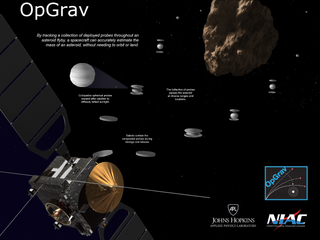NASA Has a Wild Idea to Weigh Asteroids with a Swarm of Mini Probes
Asteroids are all around us in space — but they're awfully difficult to weigh, which makes it harder to know how they'll behave.
So, NASA is considering a new spacecraft that would take a novel approach to the problem, enlisting miniature probes to skim past small asteroids. That's the idea behind OpGrav, a project that NASA and the Johns Hopkins Applied Physics Lab are testing. The asteroid-flyby project is explained in a new video from NASA released Aug. 10 on YouTube.
Here's how it would work: The main spacecraft would approach a small asteroid that scientists want to study in more detail. While the spacecraft is still a few hours away, it would release a collection of small spheres toward the asteroid.
The flock of probes would be able to safely fly closer to the asteroid than the spacecraft itself. That means the probes would be affected by the asteroid's gravity, which would pull each one a bit off course. The main spacecraft would then track where those individual probes go against the background of stars around them.

Those measurements would then allow scientists to work backward to calculate the asteroid's mass and create a map of where exactly that mass is within the asteroid. At the same time, the spacecraft could make its own observations of the asteroid to supplement data from the probes.
The method wouldn't be perfect; the smaller the asteroid, the more important it would be for the spacecraft to aim its flock well. But with larger asteroids, the technique should be able to measure the asteroids to within 1 percent of their true mass, according to a joint statement about the project.
It's too early, however, to tell when this project would be ready to fly, the statement added.
Get the Space.com Newsletter
Breaking space news, the latest updates on rocket launches, skywatching events and more!
The OpGrav asteroid concept was proposed by JHUAPL researcher Justin Atchison through the NASA Innovative Advanced Concepts program, which funds research into high-risk, high-reward space exploration concepts. The OpGrav concept received two rounds of NIAC funding between 2014 and 2015.
Email Meghan Bartels at mbartels@space.com or follow her @meghanbartels. Follow us @Spacedotcom, Facebook and Google+. Original article on Space.com.
Join our Space Forums to keep talking space on the latest missions, night sky and more! And if you have a news tip, correction or comment, let us know at: community@space.com.

Meghan is a senior writer at Space.com and has more than five years' experience as a science journalist based in New York City. She joined Space.com in July 2018, with previous writing published in outlets including Newsweek and Audubon. Meghan earned an MA in science journalism from New York University and a BA in classics from Georgetown University, and in her free time she enjoys reading and visiting museums. Follow her on Twitter at @meghanbartels.
